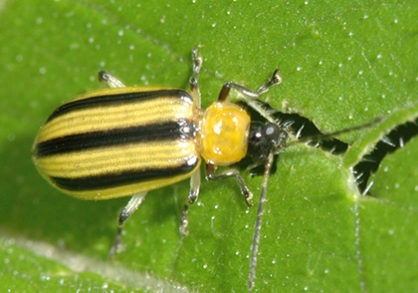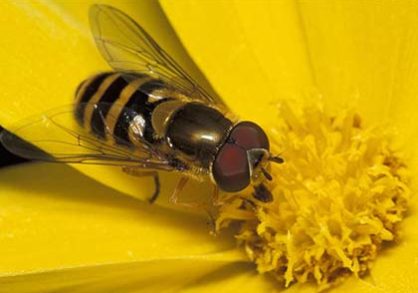From producing and adding compost, to suppressing weeds with mulch and groundcovers, to wise water use, Cornell Botanic Gardens makes every effort to garden sustainably. We minimize the use of chemical pesticides by practicing integrated pest management.
What is Integrated Pest Management?
Integrated Pest Management (IPM) brings together a range of biological, cultural, mechanical, and chemical approaches to prevent or reduce pest problems. Two full time staff implement the IPM approach for controlling insect pests and diseases on our plant collections. They work closely with staff horticulturalists to preempt any damage caused by plant pests and diseases.
Cornell Botanic Gardens IPM staff follow a yearly calendar to evaluate all plants for the presence of insect pests and diseases and use seven steps as guidelines for determining the appropriate method of control.
Prepare: Be aware of the potential problems and opportunities at your site. Know your pests and threats—and keep good records.
Prevent: Protect your landscape and buildings for the long term.
Monitor: Scout your landscape and buildings to find out which pests are on your site or in your space.
Analyze: Each plant species has a threshold, or how much damage it can take. Knowing this data will help decide whether it’s time to act.
Manage: Choose among tactics that provide the best balance of economic and environmental cost and effectiveness while reducing the risk of harming the health of the environment and people.
Apply: When management is justified, do it right.
Reevaluate: Look at your results, fine-tune your response—and make proactive plans for next time.
In addition to monitoring plant collections for pests and diseases, Cornell Botanic Gardens strives to prevent pest and disease damage by creating landscapes that benefit a diversity of animal and insect species.
We do this by:
- Using hardy and disease- and pest- resistant plant species.
- Properly planting, fertilizing, watering, pruning and mowing to maximize the health of all plants.
- Mulching to reduce the emergence of weeds.
- Introducing naturally occurring organisms to control known pests in our greenhouse such as the aphid parasite Aphidius colemani.
Scouting
Scouting for pests is a critical component of IPM, as it eliminates the need for preventative and routine pesticide application. Scouting involves surveying plants year round to determine the presence, identity and quantity of pests. Staff determine when to scout for specific insect species based on growing degree days, which is a calculation to convert daily temperatures into heat units. Each insect species requires a specific amount of accumulated heat to awaken in the spring creating a range of growing degree days assigned to specific species. This allows staff to plan when to scout targeted insects.
Before choosing chemical pesticides, staff consider a variety of mechanical, biological and cultural control techniques such as mopping away ants’ “scent trails” to food (cultural), using special vacuums for beetles (mechanical) or applying fungus to infect gypsy moths (biological).
Control Pests Naturally
Catch cucumber beetles with low-cost sticky traps.
Attract Beneficial Insects
Grow plants that attract insects for pest control and pollination.
Botanic Buzzline
This pollinator pathway was developed by four Cornell undergraduates to address pollinator decline in the Ithaca community.


